Flood Peaks and Geomorphic Processes in an Ephemeral Mediterranean Stream: Torrent de Sant Jordi (Pollença, Mallorca)
Abstract
:1. Introduction
2. Materials and Methods
2.1. Research Area
2.2. Methodology and Data
3. Results
3.1. Flood Peak Calculation for December 2004
3.2. Flood Peak Calculation for November 2005
3.3. Flood Peak Calculation for April 2007
3.4. Geomorphic Processes
4. Discussion and Conclusions
Author Contributions
Funding
Data Availability Statement
Conflicts of Interest
References
- Devitt, L.; Neal, J.; Coxon, G.; Savage, J.; Wagener, T. Flood hazard potential reveals global floodplain settlement patters. Nat. Commun. 2023, 14, 2801. [Google Scholar] [CrossRef] [PubMed]
- CRED. Disasters in Numbers; CRED: Brussels, Belgium, 2023; Available online: https://cred.be/sites/default/files/2022_EMDAT_report.pdf (accessed on 20 June 2023).
- Modrick, T.M.; Georgakakos, K.P. The character and causes of flash flood occurrence changes in mountainous small basins of Southern California under projected climatic change. J. Hydrol. Reg. Stud. 2015, 3, 312–336. [Google Scholar] [CrossRef] [Green Version]
- Sarchani, S.; Tsanis, I. Analysis of a Flash Flood in a Small Basin in Crete. Water 2019, 11, 2253. [Google Scholar] [CrossRef] [Green Version]
- Brunner, M.I.; Swain, D.L.; Wood, R.R.; Willkofer, F.; Done, J.M.; Gilleland, E.; Ludwig, R. An extremeness threshold determines the regional response of floods to changes in rainfall extremes. Commun. Earth Environ. 2021, 2, 173. [Google Scholar] [CrossRef]
- Kreibich, H.; Van Loon, A.F.; Schröter, K.; Ward, P.J.; Mazzoleni, M.; Sairam, N.; Abeshu, G.W.; Agafonova, S.; AghaKouchak, A.; Aksoy, H.; et al. The challenge of unprecedented floods and droughts in risk management. Nature 2022, 608, 80–86. [Google Scholar] [CrossRef]
- Jongman, B.; Ward, P.J.; Aerts, J.C.J.H. Global exposure to river and coastal flooding: Long term trends and changes. Glob. Environ. Chang. 2012, 22, 823–835. [Google Scholar] [CrossRef]
- Rentschier, J.; Avner, P.; Marconcini, M.; Su, R.; Strano, E.; Hallegatte, S. Rapid Urban Growth in Flood Zones: Global Evidence since 1985. Policy Research Working Paper 2022. 10014. Available online: https://blogs.worldbank.org/developmenttalk/rapid-urban-growth-flood-zones-global-trends-exposure-1985 (accessed on 16 May 2023).
- Feloni, E.; Anayiotos, A.; Baltas, E. A Spatial Analysis Approach for Urban Flood Occurrence and Flood Impact Based on Geomorphological, Meteorological, and Hydrological Factors. Geographies 2022, 2, 516–527. [Google Scholar] [CrossRef]
- Brazdil, R.; Kundzewicz, Z.W.; Benito, G.; Demarée, G.; MacDonald, N.; Roald, L.A. Historical floods in Europe in the past millennium. In Changes in Flood Risk in Europe, 1st ed.; Kundzewicz, Z.W., Ed.; CRC Press: London, UK, 2012; Volume 1, pp. 121–166. [Google Scholar]
- Blöschl, G.; Kiss, A.; Viglione, A.; Barriendos, M.; Böhm, O.; Brázdil, R.; Coeur, D.; Demarée, G.; Llasat, M.C.; Macdonald, N.; et al. Current European flood-rich period exceptional compared with past 500 years. Nature 2020, 583, 560–566. [Google Scholar] [CrossRef]
- Kaspersen, P.S.; Ravn, N.H.; Arnbjerg-Nielsen, K.; Madsen, H.; Drews, M. Comparison of the impacts of urban development and climate change on exposing European cities to pluvial flooding. Hydrol. Earth Syst. Sci. 2017, 21, 4131–4147. [Google Scholar] [CrossRef] [Green Version]
- Dottori, F.; Mentaschi, L.; Bianchi, A.; Alfieri, L.; Feyen, L. Cost-effective adaptation strategies to rising river flood risk in Europe. Nat. Clim. Chang. 2023, 13, 196–202. [Google Scholar] [CrossRef]
- European Union. European Flood Directive 2007/60/EC. Available online: https://eur-lex.europa.eu/legal-content/EN/TXT/?uri=celex:32007L0060 (accessed on 15 June 2023).
- Llasat, M.C. Floods evolution in the Mediterranean region in a context of climate and environmental change. Cuad. Investig. Geogr. 2021, 47, 13–32. [Google Scholar] [CrossRef]
- Gaume, E.; Borga, M.; Llassat, M.C.; Maouche, S.; Lang, M.; Diakakis, M. Mediterranean extreme floods and flash floods. In The Mediterranean Region under Climate Change. A Scientific Update; IRD Éditions/AllEnvi: Montpellier, France, 2016; pp. 133–144. [Google Scholar]
- Gaume, E.; Bain, V.; Bernardara, P.; Newinger, O.; Barbuc, M.; Bateman, A.; Blaškovičová, L.; Blöschl, G.; Borga, M.; Dumitrescu, A.; et al. A compilation of data on European flash floods. J. Hydrol. 2009, 367, 70–78. [Google Scholar] [CrossRef] [Green Version]
- Tarolli, P.; Borga, M.; Morin, E.; Delrieu, G. Analysis of flash flood regimes in the North-Western and South-Eastern Mediterranean regions. Nat. Hazards Earth Syst. Sci. 2012, 12, 1255–1265. [Google Scholar] [CrossRef] [Green Version]
- Llasat, M.C.; Llasat-Botija, M.; Petrucci, O.; Pasqua, A.A.; Rosselló, J.; Vinet, F.; Boissier, L. Towards a database on societal impact of Mediterranean floods within the framework of the HYMEX project. Nat. Hazards Earth Syst. Sci. 2013, 13, 1337–1350. [Google Scholar] [CrossRef] [Green Version]
- Petrucci, O.; Papagiannaki, K.; Aceto, L.; Boissier, L.; Kotroni, V.; Grimalt, M.; Llasat, M.C.; Llasat-Botija, M.; Rosselló, J.; Pasqua, A.A.; et al. MEFF: The database of MEditerranean Flood Fatalities (1980 to 2015). J. Flood Risk Manag. 2019, 12, e12461. [Google Scholar] [CrossRef] [Green Version]
- Petrucci, O.; Aceto, L.; Bianchi, C.; Brazdil, R.; Diakakis, M.; Inbar, M.; Kahraman, A.; Kiliç, O.; Kreibich, H.; Kotroni, V.; et al. FFEM-DB. Database of flood fatalities from the Euro-Mediterranean region. Sci. Data 2021, 9, 166. [Google Scholar]
- Amponsah, W.; Ayral, P.-A.; Boudevillain, B.; Bouvier, C.; Braud, I.; Brunet, P.; Delrieu, G.; Didon-Lescot, J.-F.; Gaume, E.; Lebouc, L.; et al. Integrated high-resolution dataset of high-intensity European and Mediterranean flash floods. Earth Syst. Sci. Data 2018, 10, 1783–1794. [Google Scholar] [CrossRef] [Green Version]
- Ali, K.; Bajracharyar, R.M.; Raut, N. Advances and Challenges in Flash Flood Risk Assessment: A Review. J. Geogr. Nat. Disasters 2017, 7, 195. [Google Scholar] [CrossRef] [Green Version]
- Saharia, M.; Kirstetter, P.-E.; Vergara, H.; Gourley, J.J.; Hong, Y.; Giroud, M. Mapping Flash Flood Severity in the United States. J. Hydrometeorol. 2017, 18, 397–411. [Google Scholar] [CrossRef]
- Borga, M.; Gaume, E.; Creutin, J.D.; Marchi, L. Surveying flash floods: Gauging the ungauged extremes. Hydrol. Process. 2008, 22, 3883–3885. [Google Scholar] [CrossRef]
- Gaume, E.; Borga, M. Post-flood field investigations in upland catchments after major flash floods: Proposal of a methodology and illustrations. J. Flood Risk Manag. 2008, 1, 175–189. [Google Scholar] [CrossRef]
- Borga, M.; Comiti, F.; Ruin, I.; Marra, F. Forensic analysis of flash flood response. WIREs Water 2019, 6, e1338. [Google Scholar] [CrossRef]
- Alipour, A.; Ahmadalipour, A.; Moradkhani, H. Assessing flash flood hazard and damages in the southeast United States. J. Flood Risk Manag. 2020, 13, e12605. [Google Scholar] [CrossRef]
- Roux, H.; Amengual, A.; Romero, R.; Bladé, E.; Sanz-Ramos, M. Evaluation of two hydrometeorological emsemble strategies for flash-flood forecasting over a catchment of the Eastern Pyrenees. Nat. Hazards Earth Syst. Sci. 2020, 20, 425–450. [Google Scholar] [CrossRef] [Green Version]
- Giannaros, C.; Dafis, S.; Stefanidis, S.; Giannaros, T.M.; Koletsis, I.; Oikonomou, C. Hydrometeorological analysis of a flash flood event in an ungauged Mediterranean watershed under an operational forecasting and monitoring context. Meteorol. Appl. 2022, 29, e2079. [Google Scholar] [CrossRef]
- Barriendos, M.; Ruiz-Bellet, J.L.; Tuset, J.; Mazón, J.; Balasch, J.C.; Pino, D.; Ayala, J.L. The “Prediflood” database of historical floods in Catalonia (NE Iberian Peninsula) AD 1035–2013, and its potential applications in flood analysis. Hydrol. Earth Syst. Sci. 2014, 18, 4807–4823. [Google Scholar] [CrossRef] [Green Version]
- Barriendos, M.; Gil-Guirado, S.; Pino, D.; Tuset, J.; Pérez-Morales, A.P.; Alberola-Romà, A.; Costa, J.; Balasch, J.C.; Castelltort, X.; Mazón, J.; et al. Climatic and social factors behind the Spanish Mediterranean flood event chronologies from documentary sources (14th–20th centuries). Glob. Planet. Chang. 2019, 182, 102997. [Google Scholar] [CrossRef]
- Tuset, J.; Barriendos, M.; Barriendos, J. Historical Floods on the Spanish Mediterranean Basin: A Methodological Proposal for the Classification of Information at High Spatio–Temporal Resolution—AMICME Database (CE 1035–2022). Land 2022, 11, 2311. [Google Scholar] [CrossRef]
- Romero, A.; Castejón, G. Inundaciones en la región de Múrcia en los inicios del siglo XXI. Biblio 3W 2014, XIX, 1102. [Google Scholar]
- Cortès, M.; Llasat, M.C.; Gilabert, J.; Llasat-Botija, M.; Turco, M.; Marcos, R.; Vide, J.P.M.; Falcón, L. Towards a better understanding of the evolution of the flood risk in Mediterranean urban areas: The case of Barcelona. Nat. Hazards 2017, 93, 39–60. [Google Scholar] [CrossRef]
- Gil-Guirado, S.; Pérez-Morales, A.; Lopez-Martinez, F. SMC-Flood database: A high-resolution press database on flood cases for the Spanish Mediterranean coast (1960–2015). Nat. Hazards Earth Syst. Sci. 2019, 19, 1955–1971. [Google Scholar] [CrossRef] [Green Version]
- Grimalt-Gelabert, M.; Rosselló-Geli, J.; Bauzà-Llinàs, J. Flood related mortality in a touristic island: Mallorca (Balearic Islands) 1960–2018. J. Flood Risk Manag. 2020, 4, e12644. [Google Scholar] [CrossRef]
- Ibarra, E.M. A geographical approach to post-flood analysis: The extreme flood event of 12 October 2007 in Calpe (Spain). Appl. Geogr. 2012, 32, 490–500. [Google Scholar] [CrossRef]
- Camarasa-Belmonte, A.M. Flash floods in Mediterranean ephemeral streams in Valencia Region (Spain). J. Hydrol. 2016, 541, 99–115. [Google Scholar] [CrossRef]
- Pino, D.; Ruiz-Bellet, J.L.; Balasch, J.C.; Romero-León, L.; Tuset, J.; Barriendos, M.; Mazon, J.; Castelltort, X. Meteorological and hydrological analysis of major floods in NE Iberian Peninsula. J. Hydrol. 2016, 541, 63–89. [Google Scholar] [CrossRef] [Green Version]
- Martín-Vide, J.; Llasat, M. The 1962 flash flood in the Rubí stream (Barcelona, Spain). J. Hydrol. 2018, 566, 441–454. [Google Scholar] [CrossRef]
- Grimalt-Gelabert, M.; Bauzá-Llinás, J.; Genovart-Rapado, M.C. The flood of October 9, 2018 in the city centre of Sant Llorenç des Cardassar (Mallorca). Cuad. Investig. Geogr. 2021, 47, 265–286. [Google Scholar] [CrossRef]
- Balasch, J.C.; Calvet, J.; Tuset, J. Reconstrucción post-evento del flash-flood del 1 de septiembre de 2021 en Les Cases d’Alcanar (Tarragona). Ing. Agua 2023, 27, 29–44. [Google Scholar] [CrossRef]
- Grimalt-Gelabert, M.; Alomar-Garau, G.; Martin-Vide, J. Synoptic Causes of Torrential Rainfall in the Balearic Islands (1941–2010). Atmosphere 2021, 12, 1035. [Google Scholar] [CrossRef]
- Sales, P. La invenció del pont romà de Pollença. In XXII Jornada d’Antroponímia i Toponímia (Pollença 2009); Bassa, R., Latorre, F., Eds.; Universitat de les Illes Balears: Palma, Spain, 2010; pp. 15–26. [Google Scholar]
- Tegos, A.; Ziogas, A.; Bellos, V.; Tzimas, A. Forensic Hydrology: A Complete Reconstruction of an Extreme Flood Event in Data-Scarce Area. Hydrology 2022, 9, 93. [Google Scholar] [CrossRef]
- Rodríguez, A.; Grimalt-Gelabert, M. Caudales-punta de avenida y morfología de cuencas en Mallorca. In Actas 1a Reunión Nacional de Geomorfología; Gutiérrez, M., Peña, J.L., Lozano, M.V., Eds.; Instituto de Estudios Turolenses: Teruel, Spain, 1990; pp. 427–436. [Google Scholar]
- Gaume, E.; Livet, M.; Desbordes, M.; Villeneuve, J.-P. Flash flood on 11 and 12 November 1999. Hydrological analysis of the river Aude, France. J. Hydrol. 2004, 286, 135–154. [Google Scholar] [CrossRef]
- Blaškovičová, L.; Horvát, O.; Hlavčová, K.; Kohnová, S.; Szolgay, J. Methodology for post-event analysis of flash floods—Svacenický Creek case study. Contrib. Geophys. Geodesy 2011, 41, 235–250. [Google Scholar] [CrossRef] [Green Version]
- Segura-Beltrán, F.; Sanchis-Ibor, C.; Morales-Hernández, M.; González-Sanchis, M.; Bussi, G.; Ortíz, E. Using post-flood surveys and geomorphic mapping to evaluate hydrological and hydraulic models: The flash flood of the Girona River (Spain) in 2007. J. Hydrol. 2016, 541, 310–329. [Google Scholar] [CrossRef] [Green Version]
- Mitková, V.B.; Pekárová, P.; Halmová, D.; Miklánek, P. Reconstruction and post-event analysis of a flash flood in a small ungauged basin: A case study in Slovak territory. Nat. Hazards 2018, 92, 741–760. [Google Scholar] [CrossRef]
- Cislaghi, A.; Bischetti, G.B. Best practices in post-flood surveys: The study case of Pioverna torrent. J. Agric. Eng. 2022, 53, 1312. [Google Scholar] [CrossRef]
- Payrastre, O.; Nicolle, P.; Bonnifait, L.; Brigode, P.; Astagneau, P.; Baise, A.; Belleville, A.; Bouamara, N.; Bourgin, F.; Breil, P.; et al. Tempête Alex du 2 octobre 2020 dans les Alpes-Maritimes: Une contribution de la communauté scientifique à l’estimation des débits de pointe des crues. LHB 2022, 2082891. [Google Scholar] [CrossRef]
- Riggs, H.C. A simplified slope-area method for estimating flood discharges in channels. J. Res. U.S. Geol. Sur. 1976, 4, 285–291. [Google Scholar]
- Williams, G.P. Bank-full discharge of rivers. Water Resour. Res. 1978, 14, 1141–1154. [Google Scholar] [CrossRef]
- Costa, J.E. Paleohydraulic reconstruction of flash-flood peaks from boulder deposits in the Colorado Front Range. GSA Bull. 1983, 94, 986–1004. [Google Scholar] [CrossRef]
- Rico, M.; Benito, G. Estimación de caudales de crecida en pequeñas cuencas de montaña: Revisión metodológica y aplicación a la cuenca de Montardit (Pirineos Centrales, España). Cuatern. Geomorfol. 2002, 16, 125–138. [Google Scholar]
- Rosselló Geli, J. Precipitacions i Escorrentía a les Conques Torrencials de Mallorca. Ph.D. Thesis, Universitat de les Illes Balears, Palma, Spain, 2016. [Google Scholar]
- Grimalt, M.; Rodríguez, A. Anàlisi de les Inundacions de 1990 al Vessant de Pollença; Junta d’Aigües; Govern Balear: Palma de Mallorca, Spain, 1992. [Google Scholar]
- Grimalt, M.; Rodríguez, A. Cabals maxims al Llevant i Mitjorn de Mallorca durant les revingudes de 1989. Treb. Geogr. 1990, 42, 7–18. [Google Scholar]
- Bracken, L.J.; Cox, N.J.; Shannon, J. The relationship between rainfall inputs and flood generation in south-east Spain. Hydrol. Process. 2007, 22, 683–696. [Google Scholar] [CrossRef]
- Breinl, K.; Lun, D.; Müller-Thomy, H.; Blöschl, G. Understanding the relationship between rainfall and flood probabilities through combined intensity-duration-frequency analysis. J. Hydrol. 2021, 602, 126759. [Google Scholar] [CrossRef]
- Bernet, D.B.; Trefalt, S.; Martius, O.; Weingartner, R.; Mosimann, M.; Röthlisberger, V.; Zischg, A.P. Characterizing precipitation events leading to surface water flood damage over larger regions of complex terrain. Environ. Res. Lett. 2019, 14, 064010. [Google Scholar] [CrossRef]
- Koks, E.E.; van Ginkel, K.C.H.; van Marle, M.J.E.; Lemnitzer, A. Brief communication: Critical infrastructure impacts of the 2021 mid-July western European flood event. Nat. Hazards Earth Syst. Sci. 2022, 22, 3831–3838. [Google Scholar] [CrossRef]
- Cortès, M.; Turco, M.; Llasat-Botija, M.; Llasat, M.C. The relationship between precipitation and insurance data for floods in a Mediterranean region (northeast Spain). Nat. Hazards Earth Syst. Sci. 2018, 18, 857–868. [Google Scholar] [CrossRef] [Green Version]
- Papagiannaki, K.; Kotroni, V.; Lagouvardos, K.; Bezes, A.; Vafeiadis, V.; Messini, I.; Kroustallis, E.; Totos, I. Identification of Rainfall Thresholds Likely to Trigger Flood Damages across a Mediterranean Region, Based on Insurance Data and Rainfall Observations. Water 2022, 14, 994. [Google Scholar] [CrossRef]
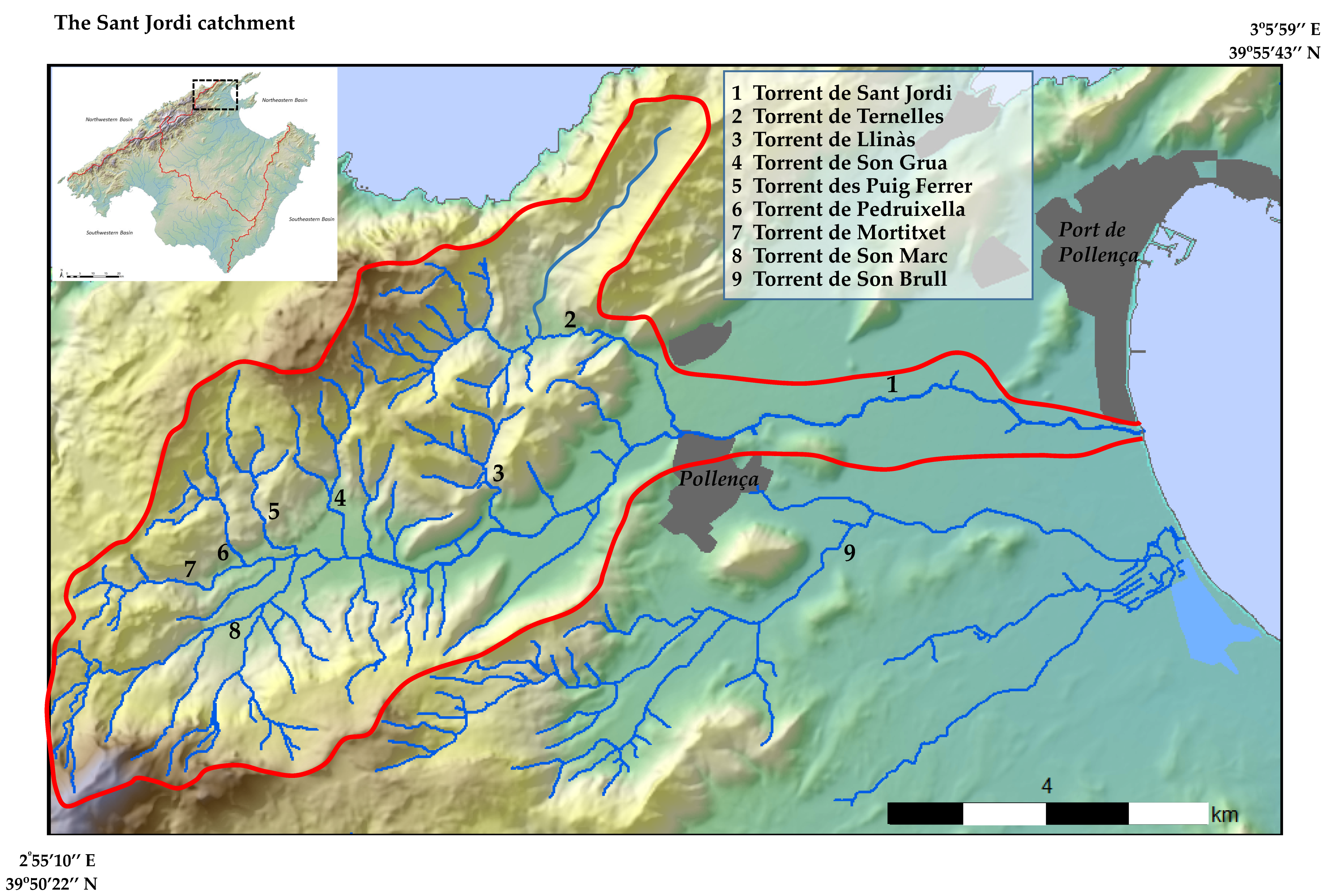

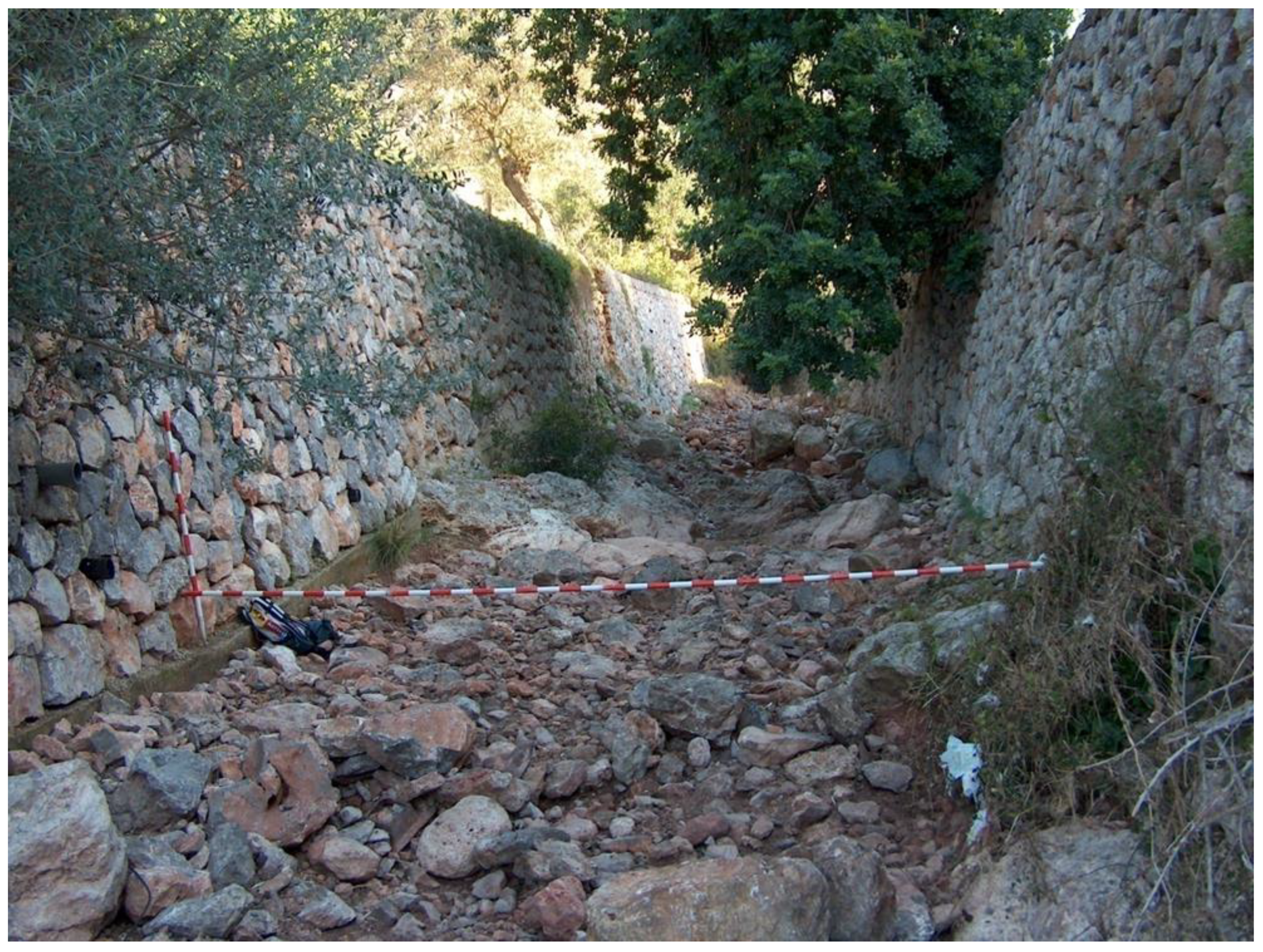
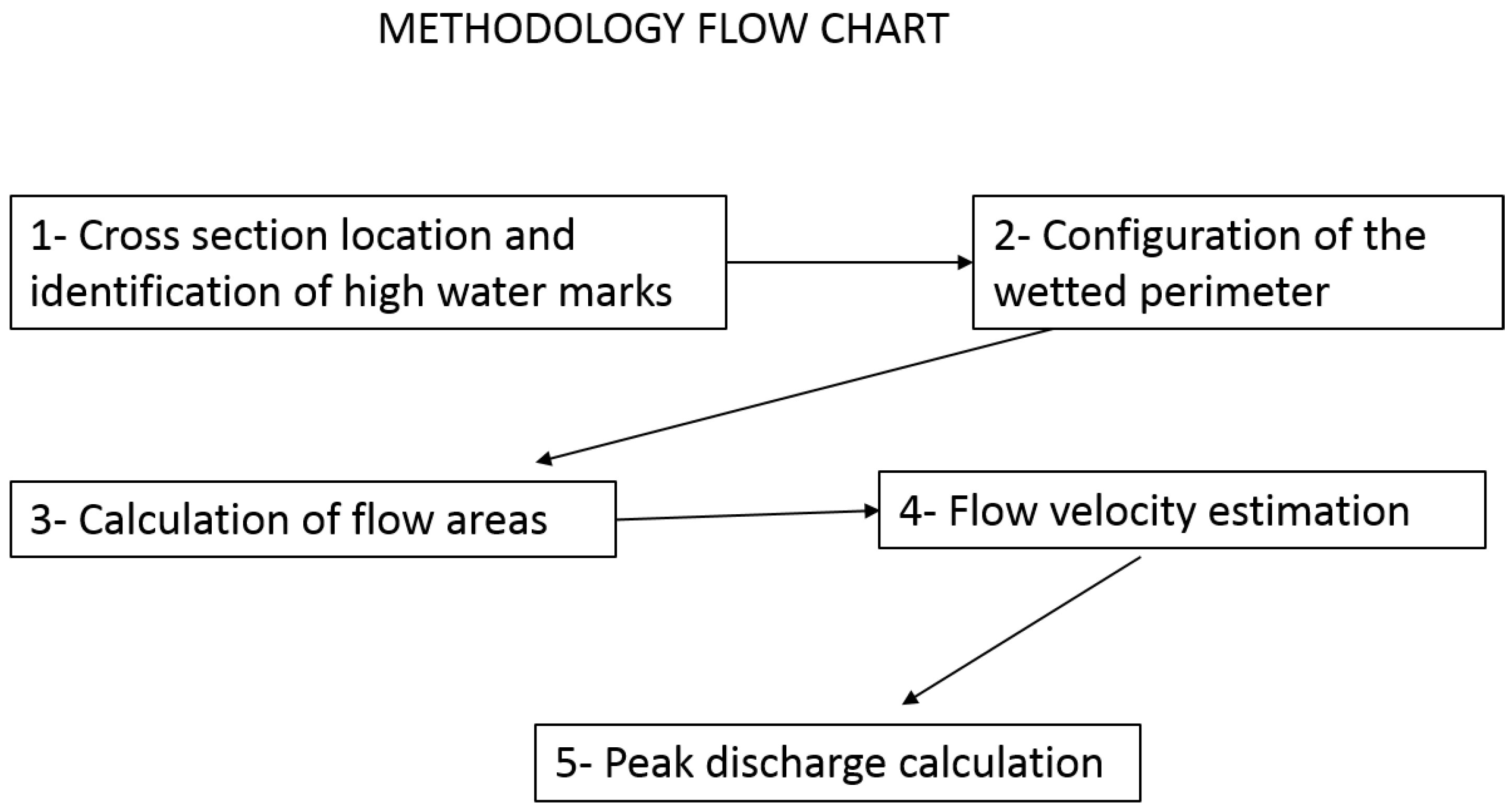

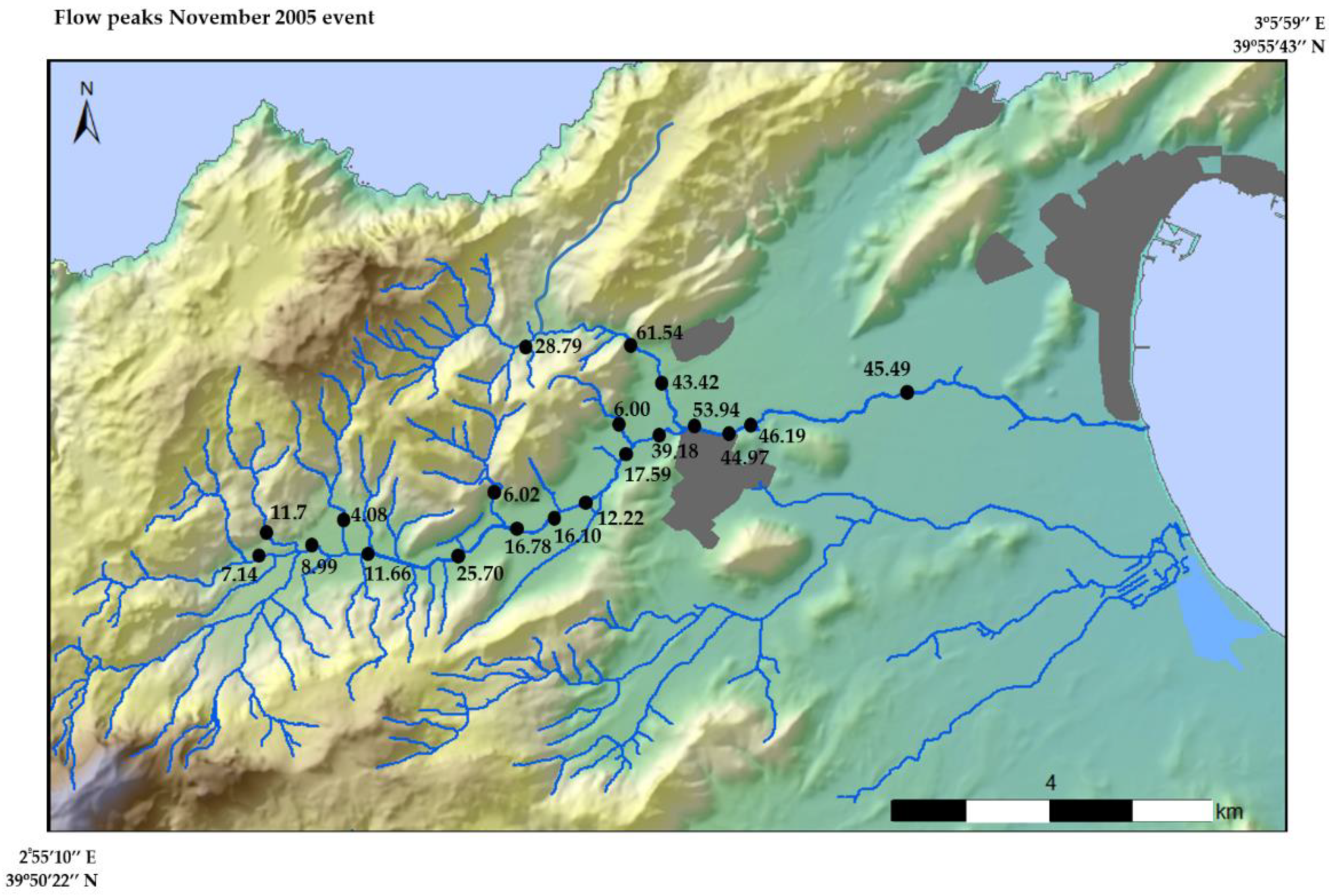
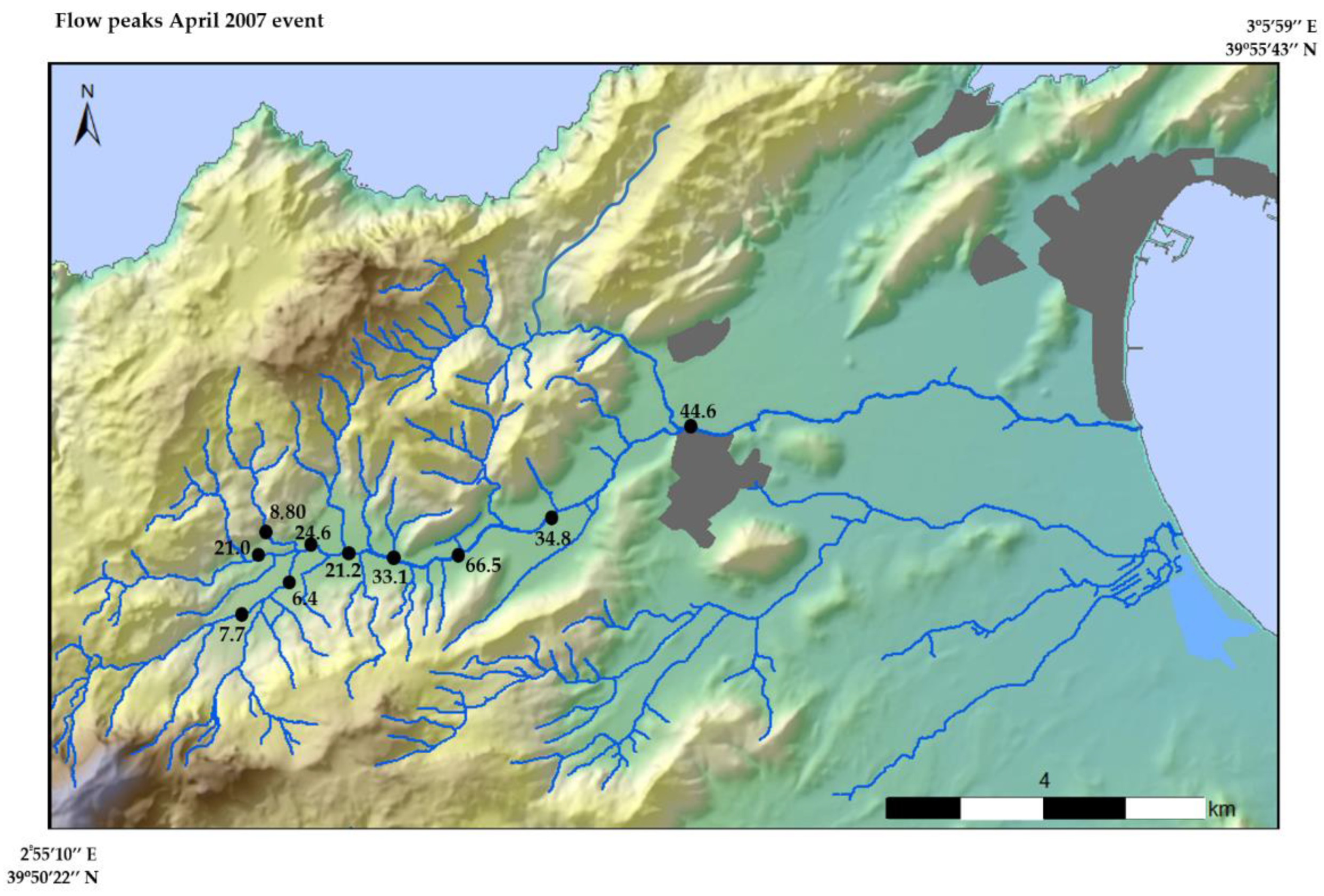
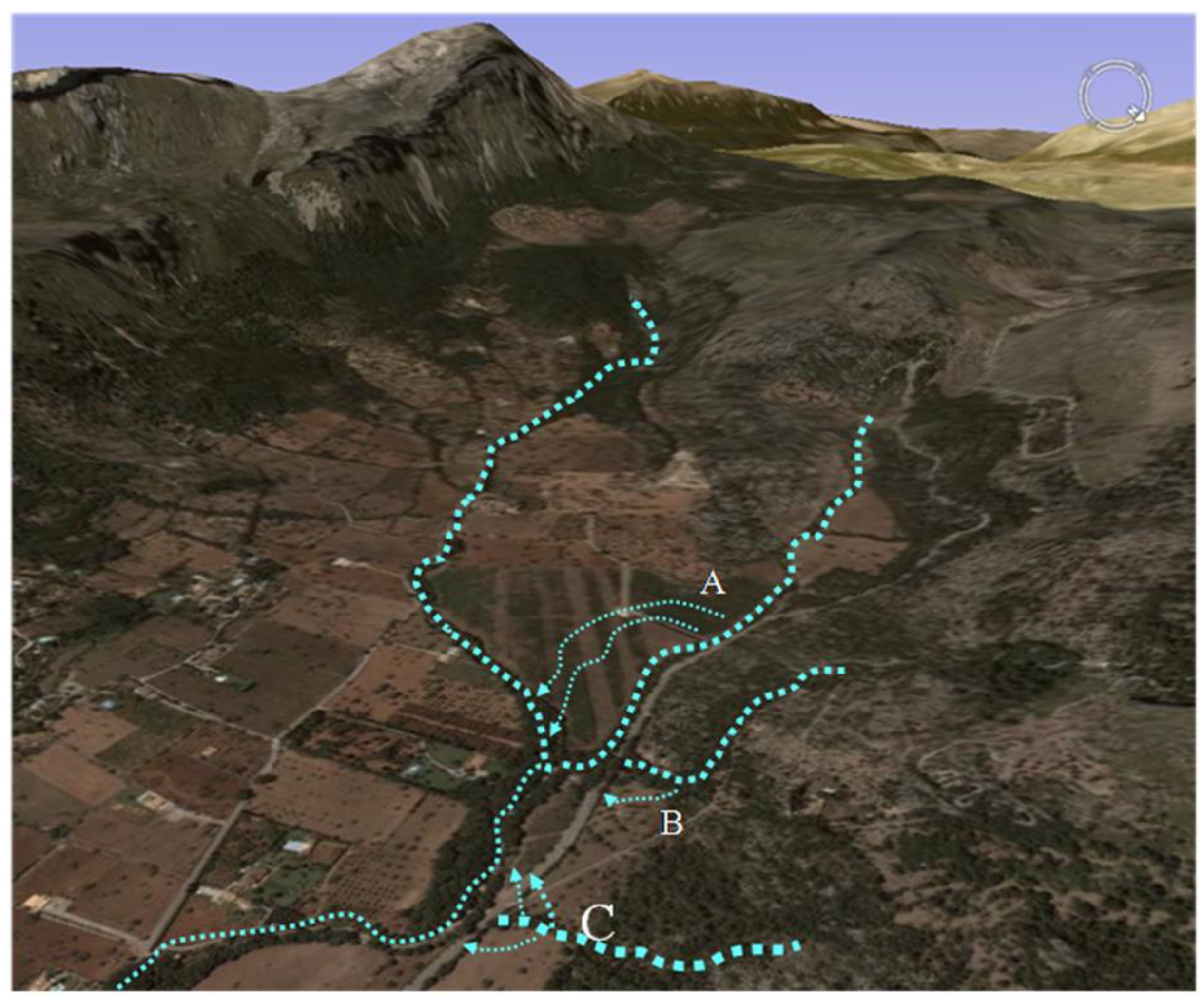

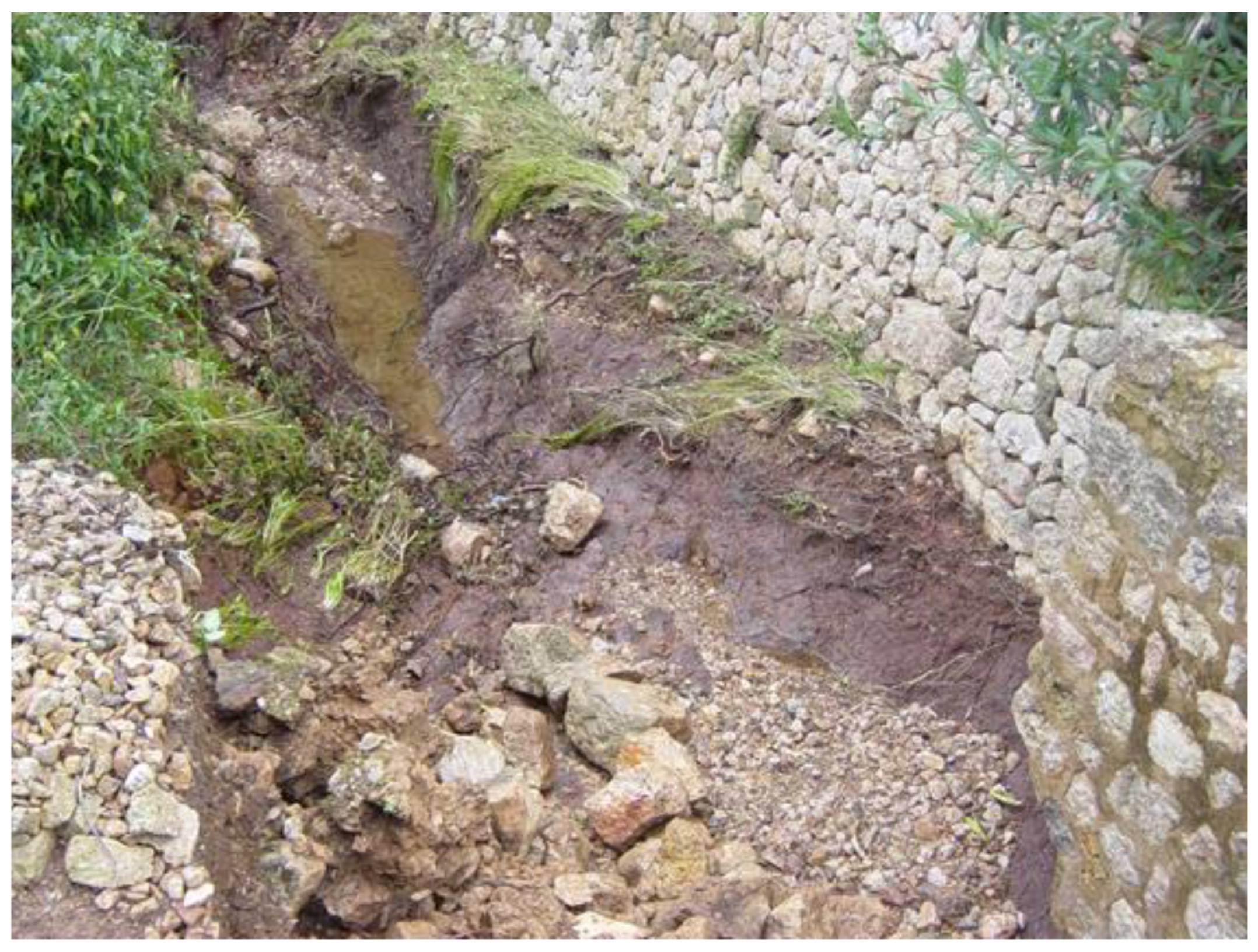
| Survey | Cross-Section (m2) | Slope (m/m) | Boulder Diameter (cm) | Critical Velocity (m/s) | Costa (m3/s) | Riggs (m3/s) | Williams (m3/s) | Final Peak (m3/s) |
|---|---|---|---|---|---|---|---|---|
| 1 | 15.4 | 0.020 | 18 | 2.29 | 35.30 | 43.37 | 39.34 | |
| 2 | 11.3 | 0.048 | 25 | 2.69 | 30.43 | 37.32 | 33.88 | |
| 3 | 12.13 | 0.0193 | - | - | - | 30.77 | 30.77 | |
| 4 | 27.4 | 0.020 | 25 | 2.69 | 73.79 | 95.88 | 84.83 | |
| 5 | 30.37 | 0.014 | - | - | - | 99.43 | 99.43 | |
| 6 | 42.66 | 0.014 | - | - | - | 158.36 | 158.36 | |
| 6b | 26.4 | 0.014 | - | - | - | 81.27 | 81.27 | |
| 7 | 27.28 | 0.008 | - | - | - | 71.60 | 71.60 | |
| 8 | 22.96 | 0.009 | - | - | - | 58.52 | 58.52 | |
| 9 | 29.66 | 0.011 | - | - | - | 89.08 | 89.08 | |
| 10 | 39.24 | 0.013 | - | - | - | - | 100.55 | 100.55 |
| Survey | Cross-Section (m2) | Slope (m/m) | Boulder Diameter (cm) | Critical Velocity (m/s) | Costa (m3/s) | Riggs (m3/s) | Williams (m3/s) | Final Peak (m3/s) |
|---|---|---|---|---|---|---|---|---|
| 1 | 4.23 | 0.020 | - | - | - | 7.14 | 7.14 | |
| 2 | 4.91 | 0.048 | - | - | - | 11.7 | 11.7 | |
| 2b | 4.06 | 0.048 | - | - | - | 8.99 | 8.99 | |
| 3 | 2.12 | 0.020 | 10 | 1.71 | 3.64 | 2.73 | 3.18 | |
| 4 | 2.15 | 0.040 | 15 | 2.1 | 4.51 | 3.49 | 4.00 | |
| 5 | 6.36 | 0.014 | 12 | 1.88 | 11.95 | 11.37 | 11.66 | |
| 5b | 5.07 | 0.014 | 8.30 | 8.30 | ||||
| 6 | 14.96 | 0.014 | - | - | - | 36.91 | 36.91 | |
| 6b | 11.53 | 0.014 | - | - | - | 25.70 | 25.70 | |
| 7 | 3.12 | 0.047 | 12 | 1.88 | 5.86 | 6.18 | 6.02 | |
| 8 | 8.25 | 0.016 | - | - | - | 16.78 | 16.78 | |
| 9 | 9.46 | 0.008 | - | - | - | 16.10 | 16.10 | |
| 10 | 7.76 | 0.008 | - | - | - | 12.22 | 12.22 | |
| 11 | 9.3 | 0.011 | - | - | - | 17.59 | 17.59 | |
| 12 | 2.89 | 0.059 | - | - | - | 6.00 | 6.00 | |
| 13 | 10.11 | 0.031 | 30 | 2.94 | 29.77 | 29.77 | 28.79 | |
| 14 | 13.48 | 0.021 | 33 | 3.09 | 41.59 | 36.76 | 39.18 | |
| 15 | 17.46 | 0.020 | - | - | - | 54.64 | 54.64 | |
| 16 | 19.34 | 0.019 | 22 | 2.53 | 48.92 | 58.97 | 53.94 | |
| 16b | 16.64 | 0.019 | 22 | 2.53 | 42.09 | 47.84 | 44.97 | |
| 17 | 19.59 | 0.012 | 22 | 2.23 | 49.54 | 51.08 | 50.31 | |
| 17b | 17.11 | 0.012 | 22 | 2.23 | 43.28 | 42.33 | 42.81 | |
| 18 | 16.51 | 0.015 | - | - | - | 43.42 | 43.42 | |
| 19 | 22.37 | 0.012 | - | - | - | 61.54 | 61.54 | |
| 19b | 18.2 | 0.012 | - | - | - | 46.20 | 46.20 | |
| 20 | 17.6 | 0.013 | - | - | - | 45.49 | 45.49 |
| Survey | Cross-Section (m2) | Slope (m/m) | Boulder Diameter (cm) | Critical Velocity (m/s) | Costa (m3/s) | Riggs (m3/s) | Williams (m3/s) | Final Peak (m3/s) |
|---|---|---|---|---|---|---|---|---|
| 1 | 8.69 | 0.020 | 23 | 2.58 | 19.57 | 22.46 | 21.02 | |
| 2 | 3.99 | 0.048 | - | - | - | 8.78 | 8.78 | |
| 3 | 4.81 | 0.014 | - | - | - | 7.67 | 7.67 | |
| 4 | 2.42 | 0.020 | 21 | 2.47 | 3.31 | 5.98 | 4.64 | |
| 5 | 3.26 | 0.019 | 20 | 2.41 | 4.95 | 7.87 | 6.41 | |
| 6 | 9.8 | 0.020 | 25 | 2.69 | 22.96 | 26.39 | 24.67 | |
| 7 | 8.32 | 0.020 | 29 | 2.89 | 18.28 | 24.09 | 21.19 | |
| 8 | 13.01 | 0.014 | 26 | 2.74 | 30.60 | 35.71 | 33.16 | |
| 9 | 22.68 | 0.014 | 66.50 | 66.50 | ||||
| 10 | 16.22 | 0.008 | - | - | - | 34.76 | 34.76 | |
| 11 | 18.04 | 0.011 | - | - | - | 44.60 | 44.60 |
Disclaimer/Publisher’s Note: The statements, opinions and data contained in all publications are solely those of the individual author(s) and contributor(s) and not of MDPI and/or the editor(s). MDPI and/or the editor(s) disclaim responsibility for any injury to people or property resulting from any ideas, methods, instructions or products referred to in the content. |
© 2023 by the authors. Licensee MDPI, Basel, Switzerland. This article is an open access article distributed under the terms and conditions of the Creative Commons Attribution (CC BY) license (https://creativecommons.org/licenses/by/4.0/).
Share and Cite
Grimalt-Gelabert, M.; Rosselló-Geli, J. Flood Peaks and Geomorphic Processes in an Ephemeral Mediterranean Stream: Torrent de Sant Jordi (Pollença, Mallorca). Hydrology 2023, 10, 152. https://doi.org/10.3390/hydrology10070152
Grimalt-Gelabert M, Rosselló-Geli J. Flood Peaks and Geomorphic Processes in an Ephemeral Mediterranean Stream: Torrent de Sant Jordi (Pollença, Mallorca). Hydrology. 2023; 10(7):152. https://doi.org/10.3390/hydrology10070152
Chicago/Turabian StyleGrimalt-Gelabert, Miquel, and Joan Rosselló-Geli. 2023. "Flood Peaks and Geomorphic Processes in an Ephemeral Mediterranean Stream: Torrent de Sant Jordi (Pollença, Mallorca)" Hydrology 10, no. 7: 152. https://doi.org/10.3390/hydrology10070152
APA StyleGrimalt-Gelabert, M., & Rosselló-Geli, J. (2023). Flood Peaks and Geomorphic Processes in an Ephemeral Mediterranean Stream: Torrent de Sant Jordi (Pollença, Mallorca). Hydrology, 10(7), 152. https://doi.org/10.3390/hydrology10070152






